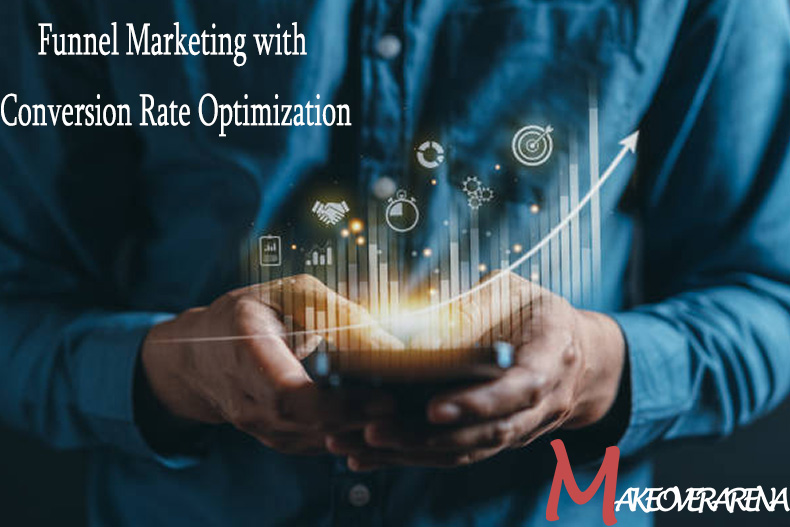Conversion Rate Optimization (CRO) is a powerful technique that allows businesses to maximize the effectiveness of their marketing funnels. It involves analyzing and making strategic changes to improve the percentage of website visitors who take desired actions, such as making a purchase or filling out a form. CRO is based on the idea that small tweaks to various elements of a website can have a significant impact on the overall conversion rate.

Implementing CRO involves understanding the user experience and identifying potential obstacles that may prevent visitors from converting. By optimizing the design, content, and functionality of a website, businesses can create a seamless and persuasive journey for their customers. CRO is a data-driven process that involves continuous testing and refining to achieve optimal results.
The Importance of Conversion Rate Optimization (CRO) in Funnel Marketing
CRO plays a crucial role in funnel marketing by ensuring that potential customers smoothly transition from one stage of the marketing funnel to the next. A well-optimized funnel guides visitors toward the desired action, increasing the likelihood of conversion. Without effective CRO techniques, businesses may lose valuable leads and potential revenue.
One of the key benefits of CRO in funnel marketing is that it helps businesses make the most of their existing traffic. By improving conversion rates, businesses can generate more leads and sales without having to invest heavily in attracting additional visitors. This makes CRO a cost-effective strategy that can deliver significant returns on investment.
Furthermore, CRO allows businesses to better understand their target audience and their preferences. Through data analysis and testing, businesses can gain insights into which elements of their website resonate most with their customers. These insights can then be applied to other marketing efforts, resulting in more effective and targeted campaigns.
Key CRO Techniques for Optimizing Conversions
Implementing CRO techniques requires a systematic approach to testing and refining various elements of a website. Here are some key techniques that can help optimize conversions:
Conducting A/B Testing
A/B testing involves comparing two versions of a web page to determine which one performs better in terms of conversions. By testing different variations of elements such as headlines, call-to-action buttons, and page layouts, businesses can identify the most effective combination. A/B testing provides valuable insights into user preferences and allows for data-driven decision-making.
Optimizing Landing Pages
Landing pages are critical components of the marketing funnel, as they are often the first point of contact for potential customers. Optimizing landing pages involves enhancing design elements, improving copywriting, and simplifying the conversion process. By removing distractions and providing a clear value proposition, businesses can increase the likelihood of conversions.
Personalizing User Experience
Personalization is a powerful technique that can significantly impact conversion rates. By tailoring content and offers based on user preferences and behavior, businesses can create a more engaging and relevant experience. Personalization can be achieved through dynamic content, targeted messaging, and personalized product recommendations.
CRO vs. SEO: The Relationship and Differences
While both Conversion Rate Optimization (CRO) and Search Engine Optimization (SEO) aim to improve website performance, they focus on different aspects of the customer journey. CRO is concerned with optimizing conversions, while SEO focuses on driving organic traffic to a website.
CRO complements SEO by ensuring that the traffic generated through SEO efforts is effectively converted into leads and sales. By optimizing the user experience and removing potential conversion barriers, businesses can make the most of their SEO efforts.
It is important to note that CRO and SEO strategies may overlap in some areas, such as improving site speed and enhancing user experience. However, their primary objectives and areas of focus are distinct. While SEO aims to increase visibility and attract more visitors, CRO aims to maximize conversions from the existing traffic.
How to Implement On-Page CRO Strategies
On-page CRO strategies focus on optimizing specific elements of a web page to improve conversions. Here are some key strategies to consider:
Clear and Compelling Call-to-Action
A strong and persuasive call to action is essential for driving conversions. It should be prominently displayed, use action-oriented language, and clearly communicate the value proposition. A/B testing can help identify the most effective call-to-action design and messaging.
Streamlined Conversion Process
Simplifying the conversion process can significantly improve conversion rates. Remove unnecessary form fields, reduce steps, and provide clear instructions to guide users through the process. Additionally, offering guest checkout options and integrating with popular payment gateways can enhance the overall user experience.
Enhancing Page Load Speed
Page load speed is a critical factor that can impact both user experience and search engine rankings. Slow-loading pages can lead to higher bounce rates and lower conversion rates. Optimizing images, minifying code, and leveraging browser caching are some techniques to improve page load speed.
How to Measure and Analyze CRO Results
Measuring and analyzing CRO results is essential to understand the effectiveness of the implemented strategies and make data-driven decisions. Here are some key metrics and tools to consider:
Conversion Rate
The conversion rate is the percentage of visitors who take the desired action, such as making a purchase or filling out a form. Tracking and analyzing conversion rates can help identify areas for improvement and measure the impact of CRO efforts.
Heatmaps and Clickmaps
Heatmaps and clickmaps provide visual representations of user behavior on a website. They show which areas of a web page receive the most attention and where users click. Analyzing these maps can help identify areas of interest and potential usability issues.
A/B Testing Tools
A/B testing tools, such as Google Optimize and Optimizely, allow businesses to conduct experiments and compare different variations of a web page. These tools provide statistical analysis and insights into which version performs better in terms of conversions.
The Role of CRO in E-commerce and Online Sales
CRO plays a crucial role in e-commerce and online sales by optimizing the customer journey and increasing conversion rates. Here are some ways CRO can benefit e-commerce businesses:
Cart Abandonment Reduction
Cart abandonment is a common challenge for e-commerce businesses. By implementing CRO techniques, such as streamlining the checkout process and offering incentives, businesses can reduce cart abandonment rates and increase sales.
Product Page Optimization
Optimizing product pages is essential for driving conversions in e-commerce. Clear product descriptions, high-quality images, and user reviews can significantly impact purchase decisions. A/B testing can help identify the most effective product page elements.
Upselling and Cross-selling Opportunities
CRO techniques can be used to identify upselling and cross-selling opportunities within the customer journey. By analyzing user behavior and preferences, businesses can tailor product recommendations and offers to increase average order value.
Frequently Asked Questions
What is Conversion Rate Optimization (CRO)?
Conversion Rate Optimization (CRO) is a technique that involves making strategic changes to a website to improve the percentage of visitors who take desired actions, such as making a purchase or filling out a form. It is based on the idea that small tweaks to various elements of a website can have a significant impact on the overall conversion rate.
How does CRO differ from SEO?
While both CRO and SEO aim to improve website performance, they focus on different aspects of the customer journey. CRO is concerned with optimizing conversions, while SEO focuses on driving organic traffic to a website.
What are some key CRO techniques?
Some key CRO techniques include conducting A/B testing, optimizing landing pages, and personalizing the user experience. These techniques involve analyzing user behavior, making data-driven decisions, and continuously refining to achieve optimal results.
How can CRO benefit e-commerce businesses?
CRO plays a crucial role in e-commerce by optimizing the customer journey and increasing conversion rates. It can help reduce cart abandonment rates, optimize product pages, and identify upselling and cross-selling opportunities, resulting in increased sales and revenue.
CHECK THESE OUT:
- The Best Crypto Debit Cards – How the Crypto Debit Cards Work | Apply for Crypto Visa Card
- What Crypto Currencies Should you Consider Getting this December?
- Influencer Video Marketing – How Do You Make A Good Influencer Video
- Essential Facebook Analytics Report for Marketers
- Direct Your Facebook Ads to Amazon and Know Your Conversion Rate



